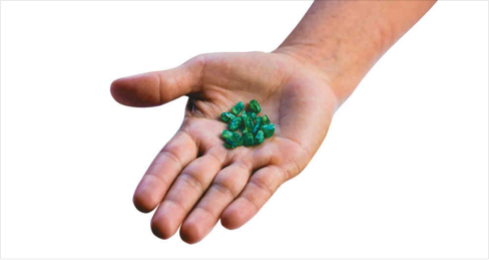
Through formalization, this industry has become a source of social development.
Most of the Colombian emeralds reach the international markets raw. Between 2004 and 2016, 48.5 million carats were exported: 40 million were sold raw; 7 million carved; and 1.5 million set, that is, mounted on a jewel.
Achieving that more and more emeralds are sold, carved and set, is one of the main longterm challenges, because unlike other minerals such as coal or gold, these are only used for luxury and fashion.
In this sense, Colombia is missing the opportunity to add value to this precious stone, since we have not managed to develop an industry that can transform it and turn it into a fine gem. Currently, many of the stones that leave the country are carved abroad and return to the country in the form of jewelry.
Informality, which has historically accompanied the sector, has become the handbrake for this industry to evolve into a finished product. The main reason is that in the supply chain, with the exception of some exporters, the vision of the marketer is to send the rough stone abroad quickly.
Likewise, the exploitation of emeralds has been in charge of small producing units: no less than 90 percent of the existing projects are small mining and only 10 percent are medium. This is one of the reasons why quite low levels of formalization are observed, where advances in modernization and environmental compliance are far from being an example of well-done mining, this being one of the main challenges of the sector.

In the last three years, the Ministry of Mines and Energy has been working on the characterization of the emerald sector in eastern Cundinamarca and western Boyacá. We have identified the technical, social, environmental and economic conditions of 234 emerald producing units.
A large part of the small miners have low levels of productivity, non-compliance with labor legislation and weaknesses in mining safety and hygiene have also been observed, which in turn is connected within the chain with a fairly high level of informality in marketing , which is mostly done from Bogotá.
The forms of work inside the mines, such as the traditional practice of paying miners with production, do not allow the generation of investment flows necessary for the technification of the same and much less to invest in the knowledge of the deposit, which results in projects with low productivity levels that take several years to search for attractive sectors without finding the vein, developing projects based on empirical methods as a result of experience.
We have also identified that behind informality there is a cultural issue, since it is thought that formalization is limited to having a mining title and in the best of cases an environmental instrument.

Big Bet
The Colombian emerald is already recognized as the most beautiful and fine in the world. It managed to be recognized and
position itself in international markets. Now the big bet is to formalize the sector, which
implies building a new industry in the long term: to grow in production and to carry out new projects in compliance with all technical, environmental and labor standards.
Exploitations such as Puerto Arturo in Coscuez, Santa Rosa and La Pita in Maripí have had significant levels of investment
that allow them to advance in modernization and exploration processes to determine the
possibility of continuing with the deposits in the long term. According to calculations by the Ministry of Mines and Energy, the emerald industry generates some 75,000 direct and indirect jobs. The entry into force in 2015 of the Single Register of Mineral Traders (Rucom), administered by the National Mining Agency, is one of the most important changes for the emerald sector, as it has contributed to the transformation and formalization of the industry.
In this sense, the National Government continues its efforts to achieve a regulated and competitive sector. Through the National Fund of Emeralds, which aims to fulfill the parafiscal contribution of the emerald, enormous efforts have been made in the defense and promotion for the development of the industry, as well as the establishment and strengthening of programs aimed at increase competitiveness and social and economic development of the sector.
In the same way and as policies to optimize the living conditions of miners, programs have been implemented to generate tools for the formalization of smallscale mining, through instruments that generate legality and modernization of the mines, as well as to continue with research and innovation in methodologies to improve the quality of the Colombian emerald. An example of this is the work of the Center for Technological Development of the Colombian Emerald – CDTEC, which will contribute in the long term to the characterization of the mineral for the determination of prices, and achieve a new green industry that is productive and enjoys greater investment.